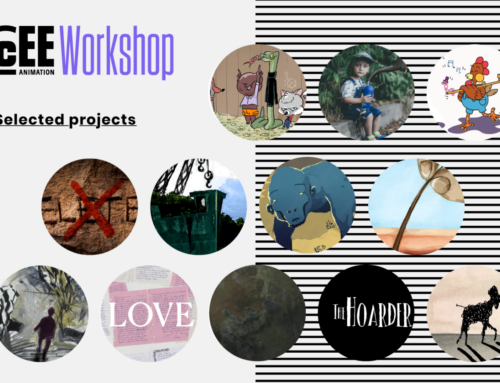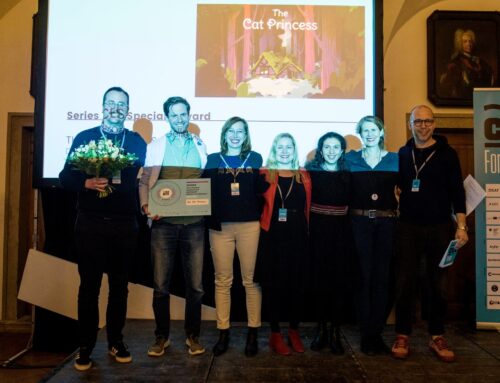Martin Vandas (MAUR film) is one of the leading Czech producers of animated film. At the moment he is working on three feature films, but also on several short films and series. His upcoming adaptation of Arnošt Goldflam’s book Of Unwanted Things and People is receiving global attention even before the start of the production and Martin believes it will be a great success.
What movies are you currently working on?
At the moment we have three feature animated films in production. We are a minor co-producer in the French-German-Czech project The Crossing, which was made using the technique of painting on glass. We’ve been on board for six years, two of which were taken up by the production itself, and if everything goes well, we’ll be finished next year. The second one is a German-Luxembourg-Czech traditional hand-drawn animation called Fritzi: A Revolutionary Tale. The third is a puppet animation of Of Unwanted Things and People based on Arnošt Goldflam’s story.
Hearing what techniques you’ve selected, one might think you’ve chosen to go against using CGI.
I’ve worked with computer animation in the past. My most expensive short film production was Ondřej Švadlena’s Time Rodent. In addition, we have another short film in production called Jama. The technology is subordinate to the theme, and whenever I have a concept in hand which goes well with CGI, I have no problem using it. It’s simply one of the options.
But the market does not accept animation in a similarly egalitarian way. It is clearly dominated by CGI.
This is true. One experienced cinema distributor has said that for him, animated film equals CGI. The children’s audience has allegedly made up their minds, if we’re talking about the mainstream. On the other hand, Mimi & Lisa is a classic 2D animation and it has found its audience too – in France a total of two hundred thousand cinema-goers came to see it.
All of the three projects you have mentioned are co-productions.
I repeat this so often that it’s become a bit of a tired cliché, but animated film and co-production are one. The times when I was making Fimfárum as a completely Czech project with exclusively Czech money and companies are long gone.
What has changed?
The whole market from audience priorities to distributor strategy. The gap between the mainstream and art has widened, and the middle category of films has disappeared. Technology has moved forward and production has become more expensive. Although the Czech Film Fund works much better today, the costs are increasing at the same time. We are also generally more open to the world – in my young years the idea of a co-production was quite exotic and the Fund did not participate in the minor ones at all.
One of the Fund’s interests is the “Czech element”. However, especially in co-production animated films, it is easy to lose contact with something so specific. How do you deal with that?
I will give you the example of Fritzi: A Revolutionary Tale. During production, it shifted to a distinctly more complex and challenging drawing than originally planned, and it was our task to adapt to it. We had to invest a lot of energy to meet the new demands, but thanks to that, we have discovered six or seven high-quality animators in the Czech environment who are now competitive all over Europe and even have other offers now. They will tell you, “We weren’t taught this at school.” It had to come through real work.
And do these shifts concern individuals or the system itself? Because there are voices saying that the Czech industry is in a deplorable state.
We are lacking institutions like the former Short Film, which employed 150 animators, so it might be difficult to systematically make your living as an animator while growing both in your career and art. But I see positive cultivation and a significant positive shift can be expected in the medium term. Just look at the activities of the Fund. When the resources allocated to animation weren’t used up because there weren’t enough applicants meeting the required conditions, it shifted the funds to other open calls without decreasing the budget or the standard. This manifests an effort to stabilise the environment without lowering the bar. We would like to see the same approach with Czech Television. We have to realise that the foundations are here – Czech animation is still world-renowned and reaps success at important festivals. After establishing the right conditions, promising filmmakers will be able to show a lot more, because animation is much more versatile than live action in terms of international distribution.
What is your experience with Czech Television?
The situation is getting better despite a few bumps in the road. Perhaps now that the production of The Crossing has taken so long, nervousness could be felt from Czech Television in asking why the production was taking so long. There were difficulties with financing on the French side, so it needed a lot of explanation and negotiations. Eventually, however, everything was settled and when the film is finished next year, believe me, it will be an event of European animated art. I believe it will run at the most prestigious festivals.
What platforms are there for authors of short film except for specialised festivals?
A short film in distribution is not as dead as many think – there are just particular steps that need to be taken. For example, our The Tree has been screened together with Green Horse Rustlers because we agreed on it with the producer in time. This is probably the only way – to be in touch with individual creators and offer them a specific film that is a good match with their own movie, if possible. The recent Romanian co-production Ceva (Somewhere), a difficult and demanding concept, was screened together with the documentary Black Shark Hunting, about the Surrealist Vratislav Effenberger.
You often do book adaptations.
It’s a practical model. You are taking up something that has already been in contact with people, and it gives you an idea of how to approach it and how it will resonate. At the same time, the book and the film can support each other in marketing, promoting each other, and creating a joint community of sympathisers. Finding the right book requires a lot of time and work, and I need to be well oriented in the environment, especially when I look beyond the borders of the Czech market. In the case of a contemporary work, you also have to learn to communicate with the writer and restrain his/her efforts to maintain their influence. For example, I found an ideal author in Arnošt Goldflam. He shows interest and willingness to cooperate, but at the same time he respects us as the creators of our own film.
Isn’t an adaptation of a Czech book a problem for a foreign market?
In Arnošt’s case, I was approached by people at Cartoon Movie asking me about a book publisher because they were interested in publishing it in Spain, for example. Other countries will follow, I think, once the movie opens in cinemas.
Author of the interview: Martin Svoboda



